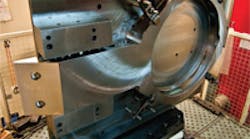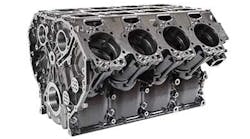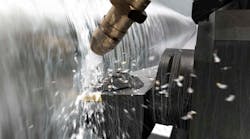Ace Precision Industries of Akron, Ohio, produces several variations of small components for mining equipment, such as cowl arms and traction reducer cases. The company recently invested in a singlespindle Niigata HD80 horizontal machining center that enables them to run larger parts with high feed/speed capabilities. Initially, Ace transferred the conventional tooling and methodology it had been using to the new equipment. The process worked, but was not optimizing the capabilities of the Niigata.
Distributor George Whalley Co. of Cleveland has been a one-stop resource for Ace’s tooling needs. Larry Wragg, the George Whalley representative, together with Tom Batchelor, Seco Tools Inc. application expert, suggested that Ace try using a Seco Power Turbo, a heavyduty square shoulder mill designed to provide maximum metal-removal with free-cutting inserts.
“The cowl arms are made of A514 steel that is flame-cut to shape, but the hardening caused by this process has always made these components tough on tooling,” Tom Stugymer, manufacturing manager at Ace, said. “We were eager to make improvements.”
The part is 62-in. long by 34-in. wide by 4.5-in. thick. Seven steps are required to produce the component. Seco initially concentrated on the first step — roughing a bore area that is 4.5-in. deep with an inside diameter range of 25 in. to 36 in. Ace had been using a 32-insert endmill to hog out the metal, which was taking over an hour on average, but they knew this method worked.
Given the speed capability of the Niigata, and considering the space constraints of the enclosed machine, Batchelor was confident they could improve the process with a helical interpolation method using Seco’s high feed milling cutter. In addition to being enclosed, the Niigata machines have internal tool changers, making it nearly impossible to get a big boring head inside the machine. “Even though conventional wisdom says we should be boring a hole, we can’t get a boring bar inside the machine due to the tool changer,” explained Stugymer. “Thus, our need to develop a more efficient method.”
High-feed milling (HFM) quickly removes a lot of material. With HFM, the cutting forces are directed axially back into the spindle. This method provides outstanding performance when machining with large overhangs.
“Ace was using a helical endmill with 32 inserts,” Batchelor said. “We applied a 4-in. diameter, high-feed mill using 218.19 inserts in Seco’s Duratomic grade MP2500.”
With this switch, the boring time was reduced by over 50 percent, to only 28 minutes. “Plus, this cutter only requires seven inserts, versus thirtytwo.” Stugymer added. “So, we cut the machining time in half with onequarter the number of inserts.”
Another aspect Seco thought it could improve operations involved the boring of two corners for stress-relief where the rod connects to the round cowl head. Ace had been machining a 1.1875-in. radius using a boring bar, because a correct-sized diameter cutter did not exist for this operation. To tackle this task, Seco made a 2.375-in. diameter Power Turbo mill with five teeth using the M14 geometry in grade F40M.
This new Power Turbo mill reduced machining time from 50 minutes to 5 minutes. Again, a plunging methodology was employed by taking 0.100-in. steps in many passes with no more than 0.05-in. depth-of-cut per pass to produce a 1.1875-in. corner radius. Spindle speed remained constant at 804 rpm, but the feedrate increased from 0.015 ipr to 0.283 ipr.
Ace is now able to manufacture about one cowl arm per day. With the switch to Power Turbo, the company saves about $28,000 per year just in machining cost on the component. This does not account for the reduced number of inserts now needed to complete the first boring operation.








